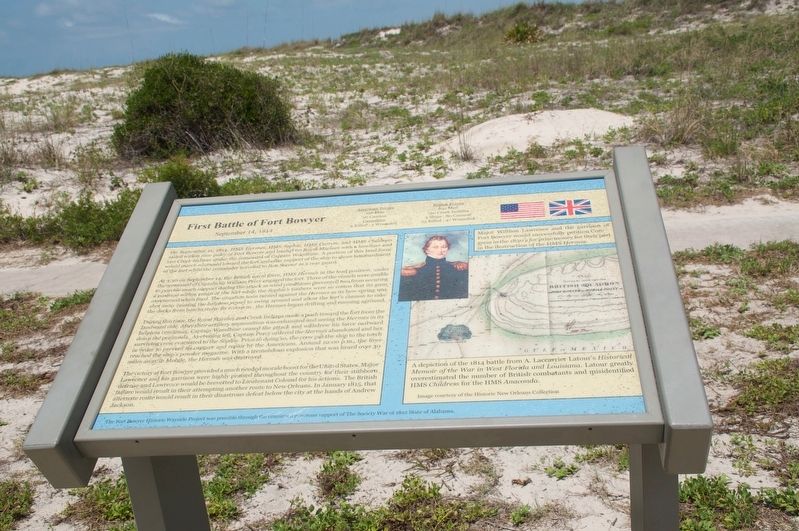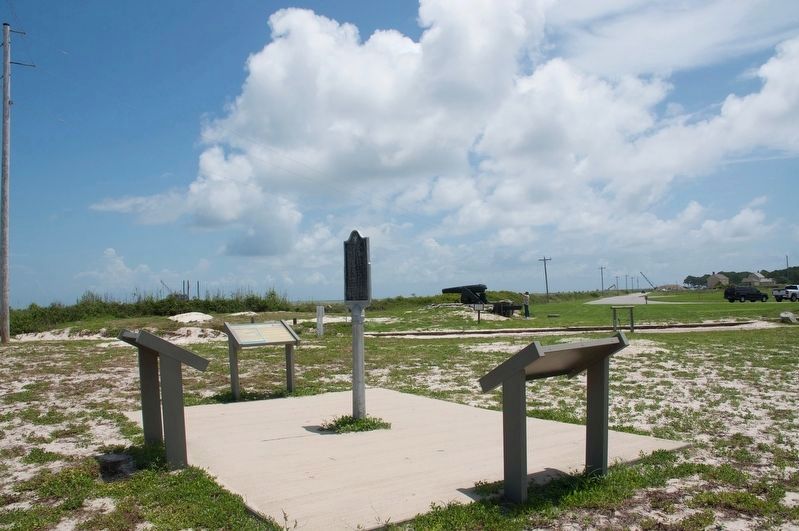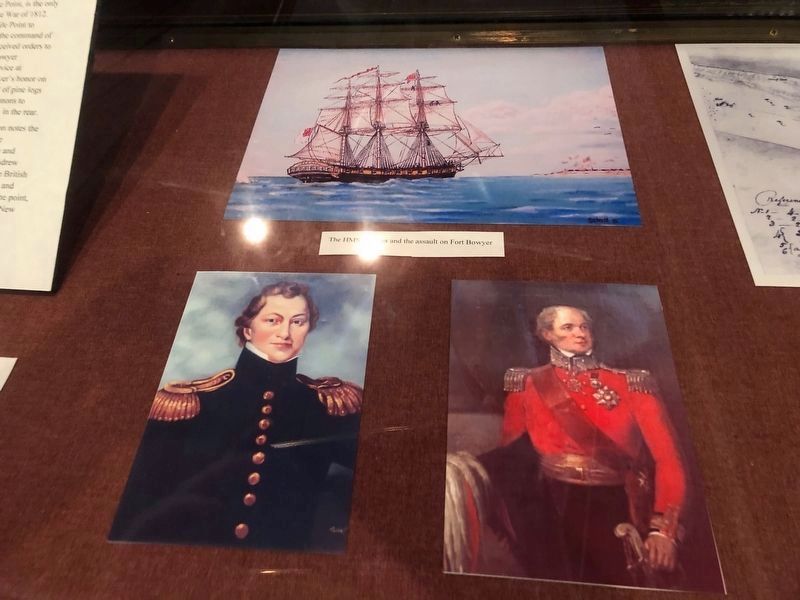Fort Morgan in Baldwin County, Alabama — The American South (East South Central)
First Battle of Fort Bowyer
September 14, 1814
American Forces
158 Men
20 Cannons
Casualties
3 Killed; 5 Wounded
British Forces
852 Men
130 Creek Indians
4 Ships; 80 Cannon
23 Killed; 47 Wounded
On September 11, 1814, HMS Hermes, HMS Sophie, HMS Carron, and HMS Childress sailed within nine miles of Fort Bowyer and landed 60 Royal Marines with a howitzer and 120 Creek Indians under the command of Captain Woodbine. A portion of this land force would march westward toward the fort and offer support of the ship to shore bombardment of the fort while the reindeer traveled to Bon Secoui as a rear guard.
At 3:30 on September 14, the British naval force, HMS Hermes in the lead position, under the command of Captain Sir William Percy engaged the fort. Three of the vessels were unable to provide much support during the attack as wind conditions prevented two from securing a position within range of the fort while Sophie’s timbers were so rotten that its guns overturned when fired. The situation soon turned against the Hermes as its bow spring was shot away causing the helpless vessel to swing around and allow the fort’s cannon to rake the decks from bow to stern. By 6:00 p.m., the Hermes began drifting and running aground.
During this time the Royal Marines and Creek Indians made a push toward the fort from the landward side. After their artillery ammunition was exhausted and seeing the Hermes in its helpless condition, Capitan Woodbine ceased the attack and withdrew his forces eastward down the peninsula. As evening fell, Captain Percy ordered the Hermes abandoned and her surviving crew evacuated to the Sophie. Prior to doing so, the crow put the ship to the torch in order to prevent its capture and repair by the Americans. Around 10:00 p.m., the fires reached the ship’s powder magazine. With a tremendous explosion that was heard over 30 miles away in Mobile, the Hermes was destroyed.
The victory at Fort Bowyer provided a much-needed morale boost for the United States. Major Lawrence and his garrison were highly praised throughout the country for their stubborn defense and Lawrence would be brevetted to Lieutenant Colonel for his actions. The British failure would result in their attempting another route to New Orleans. In January 1815, that alternate route would result in their disastrous defeat below the city at the hands of Andrew Jackson.
The Fort Bowyer Historic Wayside Project was possible through the continued generous support of The Society War of 1812 State of Alabama
Erected by The Society War of 1812 State of Alabama.
Topics. This historical marker is listed in these topic lists: Forts and Castles • War of 1812 • Waterways & Vessels. A significant historical date for this entry is September 11, 1814.
Location. 30° 13.79′ N, 88° 1.409′ W. Marker is in Fort Morgan, Alabama, in Baldwin County. Marker can be reached from Fort Morgan Road (Alabama Route 180) 2 miles west of Dune Drive, on the right when traveling west. Located at Fort Morgan, on Mobile Bay. Touch for map. Marker is in this post office area: Gulf Shores AL 36542, United States of America. Touch for directions.
Other nearby markers. At least 8 other markers are within walking distance of this marker. Second Battle of Fort Bowyer (here, next to this marker); Fort Bowyer (here, next to this marker); Fort Bowyer War of 1812 (here, next to this marker); Noble Leslie DeVotie (a few steps from this marker); 32 Pounder Sea Coast Defense Gun (within shouting distance of this marker); Battery Schenck (1899-1923) (within shouting distance of this marker); U.S. Model 1918M1 155mm Gun and Model 1918A1 Carriage (within shouting distance of this marker); Battery Thomas (1898-1917) (about 300 feet away, measured in a direct line). Touch for a list and map of all markers in Fort Morgan.
Also see . . . First Battle of Fort Bowyer. Capturing the fort would enable the British to move on Mobile and thereby block Louisiana's
trade. From Mobile, the British could move overland to Natchez to cut off New Orleans from the north.
Percy took with him HMS Hermes (22 guns), HMS Sophie (18 guns), HMS Carron (20 guns; Captain Robert Cavendish Spencer), and a fourth vessel, HMS Childers (18 guns; Capt. Umfreville). (Submitted on June 5, 2018, by Sandra Hughes Tidwell of Killen, Alabama, USA.)
Credits. This page was last revised on December 3, 2021. It was originally submitted on June 5, 2018, by Sandra Hughes Tidwell of Killen, Alabama, USA. This page has been viewed 995 times since then and 92 times this year. Last updated on December 3, 2021, by Carl Gordon Moore Jr. of North East, Maryland. Photos: 1, 2, 3. submitted on June 5, 2018, by Sandra Hughes Tidwell of Killen, Alabama, USA. • Mark Hilton was the editor who published this page.


